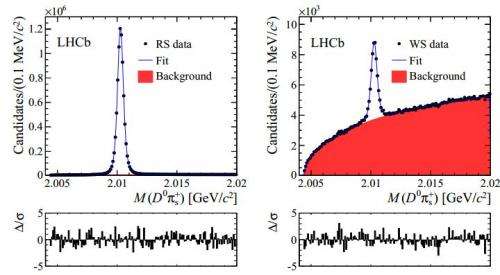March 4, 2013 report
LHC team observes first instance of D-mesons oscillating between matter and antimatter

(Phys.org) —Researchers working at the Large Hadron Collider (LHC) have observed for the first time evidence of D-mesons oscillating between matter and antimatter. They describe their work, observations and the degree of certainty they've given their findings in their paper they've uploaded to the preprint sever arXiv, which has subsequently been accepted for publication in Physical Review Letters.
Put simply, antimatter is identical to matter except that it exists with an opposite electrical charge. In this new research, the team was studying mesons—a group that along with other particles are made up of quarks. Mesons are made up of just two quarks, one matter, the other antimatter. Research over the years has led to theories that the quarks that exist as part of mesons, can oscillate between matter and antimatter. More recently, three (K-mesons and two types of B-mesons) out of the four known types of mesons had been shown to do just that, leaving just the D-meson. Now, with this new effort, researches at the LHC say their experiments have shown such oscillations exist for them as well. And so strong are the results that the team has given them a five sigma level of certainty.
Ongoing research at the LHC and other facilities has shown that subatomic particles routinely decay into other particles and that some move between existing as matter and antimatter. It's all part of a concerted effort to put together theories that hopefully in the end, explain how it all fits together and works via the Standard Model. The researchers are also hoping this new research will help explain at some point why it is that the universe appears to be made of far more matter than antimatter—common sense would suggest the two should exist in equal quantities.
The LHC has now been operating for three years, and thus far work there has proven to be fruitful. In addition to helping show that mesons conform to theory by oscillating between matter and antimatter, researchers there have also found very strong evidence to indicate the presence of the Higgs Boson, which some have suggested was reason enough to invest the billions of dollars that have been spent there.
More information: Observation of D0-D0bar oscillations, arXiv:1211.1230 [hep-ex] arxiv.org/abs/1211.1230
Abstract
We report a measurement of the time-dependent ratio of D0->K+pi- to D0->K-pi+ decay rates in D*+-tagged events using 1.0 fb^{-1} of integrated luminosity recorded by the LHCb experiment. We measure the mixing parameters x'2=(-0.9+-1.3)x10^{-4}, y'=(7.2+-2.4)x10^{-3} and the ratio of doubly-Cabibbo-suppressed to Cabibbo-favored decay rates R_D=(3.52+-0.15)x10^{-3}, where the uncertainties include statistical and systematic sources. The result excludes the no-mixing hypothesis with a probability corresponding to 9.1 standard deviations and represents the first observation of D0-D0bar oscillations from a single measurement.
Journal information: arXiv , Physical Review Letters
© 2013 Phys.org


















